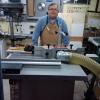
Originally Posted by
Rod Sheridan

Too many people with no training...........
Being trained in safety does not necessarily mean one will leave all the safety devices in place no matter what. I have both 10 and 30 hour OSHA certificates. I also have safety certificates in man lifts and power actuated tools. I've been the safety official on numerous job sites and as such it has been my responsibility to determine the safest way to carry out a job. Occasionally that meant re-thinking approved safety protocols and coming up with a reasonable alternative in order to get a specific job done.
When faced with the blade guard that came with my table saw, after much trial and error and modifications and adjustments, I finally determined the blade guard created a safety hazard worse than no guard at all. This was my personal decision and is by no means advocating anyone do the same. I have made other modifications and adopted certain practices that make my table saw about as safe as I can, given the options available.
My TS was made in the U.S.A. in the mid 90s. Back then I think manufacturers considered the blade guard something of an afterthought and saw little need to put any R&D into the design. I believe that is why it was so common to see table saws without blade guards. Though table saws rarely made it onto the construction site, the few I saw had no blade guards. The carpenters said they made the saw less safe and, based on my own personal experience, I had to agree.
Today, with well-designed blade guards and riving knives, I consider it definitely less safe to remove a blade guard for thru-cut operations. You just have to have one of those newer machines in your shop.
“Travel is fatal to prejudice, bigotry, and narrow-mindedness..." - Mark Twain






 Reply With Quote
Reply With Quote






